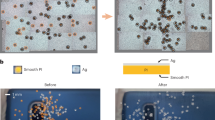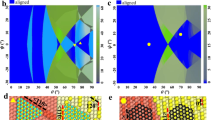Abstract
The technique used to align liquid crystals—rubbing the surface of a substrate on which a liquid crystal is subsequently deposited1,2,3—has been perfected by the multibillion-dollar liquid-crystal display industry. However, it is widely recognized that a non-contact alignment technique would be highly desirable for future generations of large, high-resolution liquid-crystal displays. A number of alternative alignment techniques have been reported4,5,6,7, but none of these have so far been implemented in large-scale manufacturing. Here, we report a non-contact alignment process, which uses low-energy ion beams impinging at a glancing angle on amorphous inorganic films, such as diamond-like carbon. Using this approach, we have produced both laptop and desktop displays in pilot-line manufacturing, and found that displays of higher quality and reliability could be made at a lower cost than the rubbing technique. The mechanism of alignment is explained by adopting a random network model of atomic arrangement in the inorganic films. Order is induced by exposure to an ion beam because unfavourably oriented rings of atoms are selectively destroyed. The planes of the remaining rings are predominantly parallel to the direction of the ion beam.
This is a preview of subscription content, access via your institution
Access options
Subscribe to this journal
Receive 51 print issues and online access
$199.00 per year
only $3.90 per issue
Buy this article
- Purchase on Springer Link
- Instant access to full article PDF
Prices may be subject to local taxes which are calculated during checkout




Similar content being viewed by others
References
DeGennes, P. G. & Prost, J. The Physics of Liquid Crystals 161 (Clarendon, Oxford, 1993).
Stöhr, J. et al. Microscopic origin of liquid crystal alignment on buffed polymer surfaces. Macromolecules 31, 1942–1946 (1998).
Stöhr, J. & Samant, M. G. Liquid crystal alignment by rubbed polymer surfaces: A microscopic bond orientation model. J. Electron Spectrosc. Rel. Phenom. 98–99, 189–207 (1999).
Aoyama, H., Yamazaki, Y., Matsura, M., Mada, H. & Kobayashi, S. Alignment of liquid crystals on the stretched polymer films. Mol. Cryst. Liq. Cryst. 72, 127–132 (1981).
Ikeno, Y. et al. Electrooptic bistability of a ferroelectric liquid crystal device using polyimide Langmuir–Blodgett orientation films. Jpn J. Appl. Phys. 27, L475–L476 (1998).
Janning, J. L. Thin film surface orientation for liquid crystals. Appl. Phys. Lett. 21, 173–174 (1972).
Schadt, M., Seiberle, H. & Schuster, A. Optical patterning of multi-domain liquid-crystal displays with wide viewing angles. Nature 381, 212–215 (1996).
Berreman, D. W. Optics in stratified and anisotropic media: 4 × 4-matrix formulation. J. Opt. Soc. Am. 62, 502–510 (1972).
Chaudhari, P., Lacey, J., Lien, S. A. & Speidell, J. L. Atomic beam alignment of liquid crystals. Jpn J. Appl. Phys. 37, L55–L56 (1998).
Chaudhari, P., Graczyk, J. F., Henderson, D. & Steinhardt, P. Transformation between random network and dense random-packed models for amorphous solids. Phil. Mag. 31, 727–732 (1975).
Acknowledgements
We thank T. Hashimoto for his encouragement and T. Ueki, H. Yamaguchi and M. Mitsuhashi for their sustained suport. P.C. thanks N. Okazaki for describing this technology to colleagues in Japan. G. Thompson photographed Figure 1.
Author information
Authors and Affiliations
Corresponding author
Rights and permissions
About this article
Cite this article
Chaudhari, P., Lacey, J., Doyle, J. et al. Atomic-beam alignment of inorganic materials for liquid-crystal displays. Nature 411, 56–59 (2001). https://doi.org/10.1038/35075021
Received:
Accepted:
Issue Date:
DOI: https://doi.org/10.1038/35075021
This article is cited by
-
Ion-beam exposure on PAM surface according to molecular concentration for application to liquid-crystal device
Journal of Materials Science: Materials in Electronics (2023)
-
Influence of orange azo dichroic dye on morphological, electro-optical, phase transition and absorption behaviour of ZnO nanoparticles-induced homeotropically aligned liquid crystal display cell
Journal of Materials Science: Materials in Electronics (2023)
-
Liquid crystal alignment effect and electro-optical characteristics of rubbing-atmospheric plasma coprocessing in ZnO alignment film according to concentration
Journal of Sol-Gel Science and Technology (2023)
-
Effects of CuInS2 nanoparticles on the alignment control of liquid crystals
Nano Research (2022)
-
A fine-ordered nanostructured bismuth tin oxide thin film constructed via sol–gel nanopatterning for liquid crystal system
Applied Physics A (2022)
Comments
By submitting a comment you agree to abide by our Terms and Community Guidelines. If you find something abusive or that does not comply with our terms or guidelines please flag it as inappropriate.



